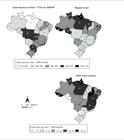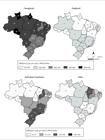Abstract
The study explores the distribution of AIDS through sociodemographic variables, within the scope of Brazilian social security and social assistance. Twenty-seven federal units were used for data spatialization and analysis. Data were stratified according to gender, age group, area of residence, social welfare membership, type of benefit received and grant method for the beneficiaries. Benefits were classified as social security (71,939, 72.4%), social assistance (26,302, 26.5%) and accident benefits (1,128, 1.1%), a large proportion of which were granted to males (64,654, 65.1%). The unemployed (50,404, 50.7%), who lived in urban areas (96,767, 97.4%), were aged between 20 and 39 years (49,508, 49.8%) and who received benefits based on article 27 of Decree Nº 3048/99 (51,985, 52.3%) were the most incident. The results show that more than half of the benefits granted were for unemployed individuals or those without job stability and, thus, did not contribute to social security for continuous periods. This fact reaffirms the segregation in the labor market to which these individuals are subjected. Also, it is noted that AIDS persists at high levels at the most productive stage of life.
Key words
AIDS; Social Security; Social Assistance

 Thumbnail
Thumbnail
 Thumbnail
Thumbnail
 Thumbnail
Thumbnail
 Source: Ministry of Social Security, 2016.
Source: Ministry of Social Security, 2016.
 Source: Ministry of Social Security, 2016.
Source: Ministry of Social Security, 2016.
 Source: Ministry of Social Security, 2016.
Source: Ministry of Social Security, 2016.